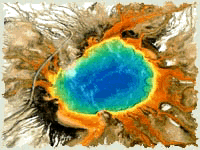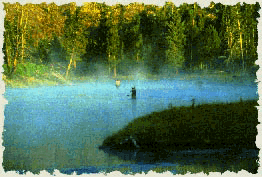“God made the heavens and the earth in six days and on the seventh He rested…I’d like to think that on the seventh day while He rested, He slept and dreamed of a wild and beautiful place. And when he awoke, there was a grizzly and a land we now call Yellowstone.”
Seven Districts of Yellowstone Park
There are 7 major areas, or districts within Yellowstone Park where all of the major attractions are found. Most will be located on the "lower loop".
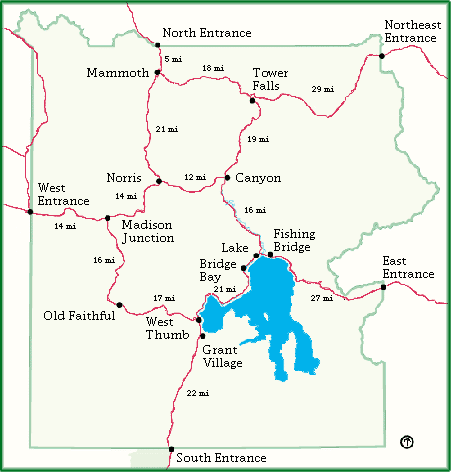
Created in 1872, Yellowstone Park is the first national park established in America and remains one of the largest; encompassing 2.2. million acres or 3,472 square miles.
Yellowstone is larger than the states of Rhode Island and Delaware combined and lies in three states – Wyoming, Montana, and Idaho. Some 350 miles of paved road wind through the park, crossing the Continental Divide three times and looks much like a figure 8; the upper and the lower grand loops.
Elevations range from approximately 5,300 feet to almost 12,000 feet. Most roads lie at around 8,000 feet.
The Madison district is best known for its fly fishing, and wildlife.
Old Faithful district is where you will spend most of your time viewing geysers, hot springs, steam vents "fumaroles", and paint pots, views along the Firehole River as well as wildlife.
The Lake district would include Yellowstone Lake as well as hot springs, fumaroles, and possibly bears.
Within the Canyon district you will find one of the better high elevation grazing meadows in Yellowstone; Hayden Valley. Your best bet at finding a bison during August. The Canyon district is also best known for its famous waterfalls, deep canyon, high elevation mountain pass and sweeping vistas as well as bears, elk and other wildlife.
The Norris district will include Norris Geyser basin, one of the more dynamic geothermal basins within Yellowstone as well as open meadow scenes with wildlife and views along the Gibbon River.
Mammoth district is home to Yellowstone Park headquarters and historical buildings as well as wildlife, and the famous travertine terraces.
The Tower / Roosevelt district is best known for its wildlife, waterfall and river scene as well as geologic evidence left behind by past volcanic eruptions. This district is considered low elevation for Yellowstone, and is spring/winter range for numerous specie of wildlife.
Old Faithful
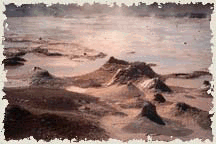
Upper Geyser Basin
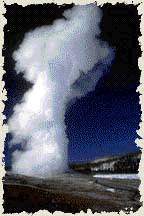
Old Faithful Geyser
Yellowstone park, as a whole, possesses close to 60 percent of the world’s geysers. The Upper Geyser Basin is home to the largest number of geysers found in the park. Within one square mile there are at least 150 of these hydrothermal wonders. Of this number, only five major geysers are predicted regularly by the naturalist staff. They are: Castle, Grand, Daisy, Riverside, and Old Faithful. There are many frequent, smaller geysers to be seen and marveled at in this basin as well as numerous hot springs and one recently developed mud pot.
Lower Geyser Basin
This large area of geothermal activity can be viewed by foot along the boardwalk trail at Fountain Paint Pots and by car along the three mile Firehole Lake Drive. The latter is a one-way drive where you will find the sixth geyser predicted by the Old Faithful staff: Great Fountain. Its splashy eruptions send jets of water bursting 100-200 feet in the air, while waves of water cascade down the raised terraces. Patience is a virtue with this twice-a-day geyser, as the predictions allow a 2 hour +/- window of opportunity.
Fountain Paint Pot trail is one of my favorite thermal areas to visit, and contains all four types of thermal features found in Yellowstone. They are: hot springs, mud or paint pots, steam vents, and geysers.
Midway Geyser Basin
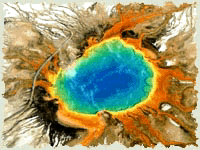
This geyser basin, though small in size compared to its companions along the Firehole River, holds large wonders for the visitor. Excelsior Geyser reveals a gaping crater 200 x 300 feet with a constant discharge of more than 4,000 gallons of water per minute into the Firehole River. Also in this surprising basin is Yellowstone’s largest hot springs, Grand Prismatic Spring. This feature is 370 feet in diameter and more than 121 feet in depth.
Lone Star Geyser Basin
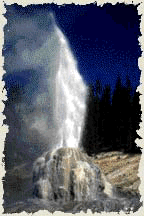
There is a logbook located in a raised wooden cache near the geyser for observations of geyser times and types of eruptions. There are minor eruptions every 1.5 hours. When you look at the logbook you will note that all of the eruptions recorded by visitors are “major” 🙂
The trail is an old road which visitors in the 20’s and 30’s were able to drive on and is a very easy hike. While hiking in, ask the hikers you pass on their way out if they had witnessed Lone Star erupt. You can then estimate the next eruption based on their recorded eruption. Note: all of those asked will say they saw a “major eruption”.
Shoshone Geyser Basin
Shoshone Geyser Basin is reached by a 17-mile round trip hike that crosses the Continental Divide at Grant’s Pass. This basin has no boardwalks and extreme caution should be exercised when traveling through it. Trails in the basin must be used. Remote thermal areas should be approached with respect, knowledge, and care. Be sure to emphasize personal safety and resource protection when entering a backcountry basin. The easiest way to view this basin is to canoe into Shoshone lake via Lewis lake and camping out. A permit is required to camp here as well as all other backcountry campsites. see Backcountry Camping
Firehole River

The river derives its name from the steam (which they thought was smoke from fires) witnessed by early trappers to the area. Their term for a mountain valley was “hole,” and the designation was born. The Firehole River boasts a world-famous reputation for fly-fishing. Brown, rainbow, and brook trout give the angler a wary target in this stream. Fishing permits are required to fish in Yellowstone park. Click Here for more information on fishing permits.
What causes this geothermal activity?
The earth’s crust here is less than 40 miles thick (the average is closer to 90 elsewhere). Molten magma 3-4 miles below the surface results in volcanic activity, geyser eruptions, and hot springs.
Super volcanic eruptions in Yellowstone Park have occurred 3 times, almost every 16,000 years. The first super eruption, which occurred 2.1 million years ago was the largest of the three and massive in size. Ash deposits 15 feet deep have been found as far south as Mexico, and as far east as Iowa.
This first, massive eruption has been estimated to have been about 6000 times more powerful than the blast of Mt. St. Helens in 1981. The Yellowstone volcano is the largest in the world and is classified as a super volcano. Only 30 super volcanoes exist in the world, and Yellowstone is the only one on land. The remaining 29 are scattered over the worlds oceans.
After the last eruption, which occurred about 640,000 years ago, the remaining earths surface collapsed in on itself leaving a large 50 mile long X 25 mile wide high elevation flat plateau, or caldera under which lies the worlds largest magma chamber. Since the last major super eruption, Yellowstone has experienced 30 smaller volcanic eruptions. Evidence of these smaller eruptions can be found throughout the park.
There is no evidence at this time, that Yellowstone is about to erupt.
Mammoth
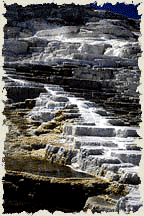
Mammoth Hot Springs are the main attraction of the Mammoth District. These features are quite different from thermal areas elsewhere in the park. Travertine formations grow much more rapidly than sinter formations due to the softer nature of limestone; up to 12″ per year. As hot acidic water rises through limestone, large quantities of rock are dissolved by the hot water, and a white chalky mineral (calcium carbonate) is deposited on the surface. When the water reaches the surface, it has a balanced ph of 7.0 due to the large amount of calcium carbonate which the acid water has dissolved.
Although visitors are sometimes confused by the rapidly shifting activity of the hot springs and disappointed when a favorite spring appears to have “died,” it is important to realize that the location of springs and the rate of flow changes daily, that “on-again-off-again” is the rule, and that the overall volume of water discharged by all of the springs fluctuates little.
Most of the geothermal features found in the park average 200° F. Some are much hotter. Stay on the boardwalks and marked trails. Each year a few visitors are seriously burned, some have died. The boardwalks are there for your safety and protection.
Norris Geyser Basin
Norris Geyser Basin is the hottest, oldest, and most dynamic of Yellowstone Park’s thermal areas. The highest temperature yet recorded in any geothermal area in Yellowstone was measured in a scientific drill hole at Norris: 459 degree’s F just 1,087 feet below the surface! There are very few thermal features at Norris under the boiling point (199F at this elevation). Norris shows evidence of having had thermal features for at least 115,000 years.
The features in the basin change daily with frequent disturbances from seismic activity and water fluctuations. The vast majority of the waters at Norris are acidic, including acid geysers which are very rare. Steamboat Geyser, the tallest geyser in the world (300 to 400 feet) and Echinus Geyser (pH 3.5) are the most popular features.
Update: Echinus has been under change for the past couple of years. The pH has changed from acidic to more neutral and has been testing at around 6.5, also increasing in temperature — 172 degree’s, which has allowed algae beds to form in the run-off channel.
The basin consists of three areas: Porcelain Basin, Back Basin, and One Hundred Springs Plain. Porcelain Basin is barren of trees and provides a sensory experience in sound, color, and smell; a 3/4 mile dirt and boardwalk trail accesses this area. The Back Basin is more heavily wooded with features scattered throughout the area; a 1.5 mile trail of boardwalk and dirt encircles this part of the basin.
One Hundred Springs Plain is an off-trail section of the Norris Geyser Basin that is very acidic, hollow, and dangerous. Travel is discouraged without the guidance of knowledgeable staff members. The area was named after Philetus W. Norris, the second superintendent of Yellowstone, who provided the first detailed information about the thermal features.
*Activity At Norris Geyser Basin*
Following several swarms of earthquakes in the Norris Geyser Basin area in May of 1999, some of the Basin’s geysers are now displaying changes. The most noticeable change is with Echinus Geyser, one of the Park’s most popular and most predictable geysers. The time between eruptions of Echinus since May of 1999 has been unpredictable, whereas the geyser had been erupting prior to 1999 roughly every 70 minutes.
The worlds largest geyser, Steamboat, erupted for the fourth time in just over a year on April 27th, 2003. Prompting new questions about increased activity for the worlds biggest geyser.
Intervals between eruptions at Steamboat — famously unpredictable and spectacular geyser–historically range from about four days to 50 years. After a relatively quiet two years following an eruption in May 2000, Steamboat erupted April 26, 2002; Sept. 14, 2002; March 26, 2003 and again on April 27, 2003.
July 2003: Due to some major changes within the back basin, park rangers closed off most of the boardwalk.
Sept. 2003: The boardwalk in the back basin reopened with the addition of a new boardwalk, and conditions improved, but keep in mind that change in Yellowstone is constant, and you may encounter a sudden increase in thermal activity with little or no notice. Always think safety while touring one of our many geothermal areas.
Grand Canyon of the Yellowstone
The Grand Canyon of the Yellowstone is one of the more impressive sights found in Yellowstone Park and one of the most popular. It is famous for its colors, shapes, and waterfalls. The canyon contains just two of 400 waterfalls found in Yellowstone, but they are the largest.
The best time of year to photograph the Canyon is the first two weeks of October. The sun has set far enough on the horizon that it highlights one side of the canyon in light and shades the opposite side. The North rim is better photographed in early morning in Oct. and the South rim in the afternoon.
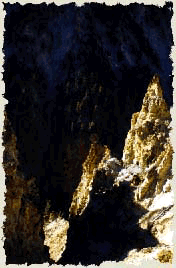
The canyon as we know it today is a very recent geologic feature. The present canyon is no more than 10,000 to 14,000 years old, although there has probably been a canyon in this location for a much longer period. The exact sequence of events in the formation of the canyon is not well understood, as there has been little field work done in the area. The few studies that are available are thought to be inaccurate. We do know that the canyon was formed by erosion rather than by glaciation.
The geologic story of the canyon, its historical significance as a barrier to travel, its significance as destination/attraction, and its appearance in Native American lore and in the accounts of early explorers are all important interpretive points. The “ooh-ahh” factor is also important: its beauty and grandeur, its significance as a feature to be preserved, and the development of the national park idea.
Yellowstone Tour Guide Information–here |
The Upper and Lower Falls of the Yellowstone
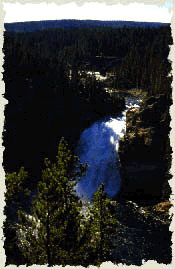
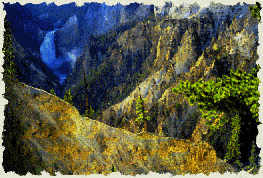
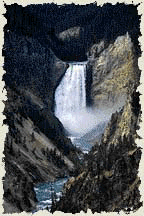
A third falls can be found in the canyon between the Upper and Lower falls. Crystal Falls is the outfall of Cascade Creek into the canyon. It can be seen from the South Rim Trail just east of the Uncle Tom’s area.
The Yellowstone River is the force that created the canyon and the falls. It begins on the slopes of Yount Peak, south of the park, and travels more than 600 miles to its terminus in North Dakota where it empties into the Missouri River. It is the longest un dammed river in the continental United States.
Just South and upstream of the upper falls is Hayden Valley. This valley was once thought to be part of Yellowstone Lake farther upstream. The theory is a large glacier blocked off the Yellowstone river somewhere near the upper falls and forced silt to fill in that section of the lake forming Hayden Valley. In late July and all of August Hayden Valley is the home to the majority of bison in the park and is their historical mating ground.
Yellowstone Park is also home to abundant and varied wildlife, unlike anywhere else in America. Nearly all wildlife species that inhabited the park when it was first explored over 100 years ago survive today. Click here to view just a sample of a few.
Suggested Reading:
“Roadside History of Yellowstone Park”. by Winfred Blevins, Mountain Press Publishing Company
“A Field Guide To Yellowstone’s Geysers, Hot Springs, and Fumaroles”, by Carl Schreier, Homestead Publishing
“Yellowstone, A National Park Waterfall Guide”. by Charles Maynard, Panther Press
“Nature’s Yellowstone”. by Richard A. Bartlett, The University of Arizona Press
“Mountain Time, Man Meets Wilderness in Yellowstone”. by Paul Schullery, Simon and Schuster Inc.
“A Yellowstone Album, A Photographic Celebration of the First National Park”. Lee Whittlesey, et al, Yellowstone Foundation
Submit your review | |

